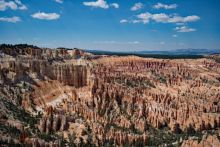Geoscience Currents transmit snapshots of the many facets of the geoscience profession, in-depth case studies of how geoscience is applied, factsheets that provide rigorous introductions to a range of geoscience topics, workforce trends, and career paths.
Partner with us to help support well-informed public policy and decision making with expert, impartial geoscience information. Visit our Sponsorships page for more information or email sponsorships@americangeosciences.org.
Displaying 181 - 190 of a total of 225 items

June 29, 2011
Recruitment and retention discussions about the 'pipeline model' have been circulating through the STEM community for years, with a primary focus on attrition rates (termed 'leaks'). However, the pipeline model is not conducive for understanding variations in students’ experiences, behaviors and...

May 20, 2011
AGI contacted 262 four-year institutions of higher learning to determine whether or not they accept a high school Earth science course for admission. At least three schools were contacted per state (state schools as well as private institutions). As of May 8, 2011, 226 schools responded. (This...

March 28, 2011
The American Geological Institute (AGI) hosted the First Earth System Science (ESS) Education Summit in Houston, Texas, at BP Exploration’s new Helios Plaza meeting facility on February 8-11, 2010. The Summit was supported by a grant from the National Science Foundation, as well as by funding from...

March 11, 2011
The majority of geoscientists in the workforce are within 15 years of retirement age, and data from federal sources, professional societies, and industry indicate a growing imbalance in the age of geoscientists in the profession. Over the past three years, marked shifts in the age demographics for...

March 04, 2011
The percentage of all federal funding for research and development applied to the geosciences decreased from nearly 11% in 1996 to 6% in 2007, where it has held steady ever since. The total amount of federal research funding for geoscience research steadily increased between 1970 and 2004, peaking...

December 10, 2010
According to data collected by the National Association of Colleges and Employers in their 2010 Fall Salary Survey, starting salary offers for geoscience graduates were highest for those graduating with geoscience-related engineering degrees (e.g. petroleum engineering, mining engineering, and...

September 10, 2010
EDMAP is a matching-funds grant program with universities that is an interactive and meaningful program for students to gain experience and knowledge in geologic mapping as well as contribute to the national effort -- Federal, State, university -- to geologically map all of the United States. This...

August 18, 2010
The NSF Graduate Fellowship program conferred an average of 927 graduate fellowships per year between 2000 and 2008, the majority (56-59%) of which were awarded to graduate students in the life sciences and engineering fields. During this period, approximately 3.5 percent of NSF graduate...

July 06, 2010
Despite the U.S. economy’s downturn, geoscience salaries increased by 3.1 percent between 2008 and 2009, which is slightly more than the salary growth for other science occupations (2.1%) and for all U.S. occupations (2.8%). In 2009, the top geoscience salaries were for management positions (...

June 11, 2010
Seven-hundred eighty-three students in introductory geology classes were surveyed at Northern Arizona University during the fall 2008 and spring 2009 semesters to evaluate perceptions and attitudes toward the sciences that are offered as undergraduate degree programs: Biology, Chemistry,...
Pages
Upcoming Webinars

